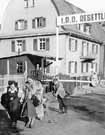
|
|
|

|

|

|

|
|
Click on an image to see a larger, more detailed picture.
|
|
|
|
|
| EPILOGUE: The Aftermath |

|
pg. 689 |

|
|
|
|
| |
|
For Jewish refugees, however, France was less than a safe haven. The Sapirs were eventually rounded up and placed in a concentration camp. Josef Sapir was deported to Poland; he was killed at Majdanek in 1943. Estelle avoided her father's fate, became active in the Resistance, and took care to remember one of the last things her father had told her: Remember, he urged her, Credit Suisse holds the family money-- $82,000 of it (as valued in the 1940s). If Estelle survived, he made her promise, she must claim the Sapir money from Credit Suisse--and the other banks he had frequently identified--so the family could go on. Reunited with her mother in Paris after the war, Estelle tried to keep her promise by claiming her father's Swiss bank accounts. The officials at Credit Suisse were not helpful. No funds would be released without her father's death certificate. The Nazis killed Jews and counted the deaths at Majdanek, but they issued no death certificates. Estelle did have other evidence about her father, including Nazi records documenting Josef's deportation to Majdanek on March 6, 1943. For the Swiss banks, this documentation was insufficient. Persistently, Sapir kept trying to recover her family's assets.
|
 In postwar DP camps (above), scrip replaced real currency. Years later it was revealed that Swiss banks and other institutions had benefited from the Nazi theft of Jewish assets.
In postwar DP camps (above), scrip replaced real currency. Years later it was revealed that Swiss banks and other institutions had benefited from the Nazi theft of Jewish assets.
Photo: Bilderdienst SYddeutscher Verlag
|
 When American GIs needed housing, DPs were the first to be relocated (above). When European financial institutions wished to profit from "unclaimed" depositor assets after the war, Jewish property was chosen
When American GIs needed housing, DPs were the first to be relocated (above). When European financial institutions wished to profit from "unclaimed" depositor assets after the war, Jewish property was chosen
Photo: Bilderdienst SYddeutscher Verlag
|
|
German Reparations In 1952 the democratic Federal Republic of Germany (West Germany) agreed to pay reparations to the state of Israel and to make restitution to Jewish people throughout the world for the crimes committed by the Third Reich. Since that time, billions of dollars have flowed into the Israeli economy, the budgets of Jewish organizations, and directly to individuals. Claims for the restitution of Jewish property and indemnification were made as early as 1945. However, it was German Chancellor Konrad Adenauer's official proclamation in support of these claims that paved the way for the program that began eight years later. Israel's first merchant fleet and its highly modernized agricultural industry were bankrolled by the German government. Hundreds of Jewish communities and organizations in Europe and other locations were rehabilitated with funds that flowed from West Germany. Moreover, restitution was made to thousands of people who were persecuted by the Nazis.
|
|

|

|

|

|
 November 1996: Volkswagen AG is embarrassed by a 1055-page history commissioned by the company. The book reveals details of Volkswagen's wartime use of Russian POWs and Jewish concentration-camp inmates as slave laborers.
November 1996: Volkswagen AG is embarrassed by a 1055-page history commissioned by the company. The book reveals details of Volkswagen's wartime use of Russian POWs and Jewish concentration-camp inmates as slave laborers.
|
 December 1996: Northwestern University engineering professor and historical revisionist Arthur R. Butz, who calls the Holocaust "the extermination legend," is at the center of controversy because the university provides him with free Internet access via the school's Web server, through which Butz presents his ideas to an enormous audience. A Jewish professor who criticizes the university's position during classtime is dismissed.
December 1996: Northwestern University engineering professor and historical revisionist Arthur R. Butz, who calls the Holocaust "the extermination legend," is at the center of controversy because the university provides him with free Internet access via the school's Web server, through which Butz presents his ideas to an enormous audience. A Jewish professor who criticizes the university's position during classtime is dismissed.
|
 December 16, 1996: Five Swedish members of the National Socialist Front are sentenced to two months' imprisonment for participating in a ceremony at Trollhättan to commemorate the 1987 death of Rudolf Hess.
December 16, 1996: Five Swedish members of the National Socialist Front are sentenced to two months' imprisonment for participating in a ceremony at Trollhättan to commemorate the 1987 death of Rudolf Hess.
|
|
|
|
|
| EPILOGUE: The Aftermath |

|
pg. 689 |

|
|
The Holocaust Chronicle
© 2009 Publications International, Ltd.
|
|
